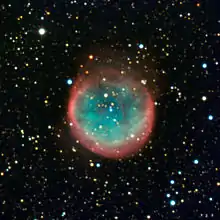NGC 6781
NGC 6781 is a planetary nebula located in the equatorial constellation of Aquila, about 2.5° east-northeast of the 5th magnitude star 19 Aquilae.[3] It was discovered July 30, 1788 by the Anglo-German astronomer William Herschel.[5] The nebula lies at a distance of 1,500 ly from the Sun.[2] It has a visual magnitude of 11.4 and spans an angular size of 1.9 × 1.8 arcminutes.[3]
| Emission nebula | |
|---|---|
| Planetary nebula | |
 NGC 6781 from the La Silla Observatory | |
| Observation data: J2000 epoch | |
| Right ascension | 19h 18m 28.085s[1] |
| Declination | +06° 32′ 19.29″[1] |
| Distance | 1,500 ly (460[2] pc) |
| Apparent magnitude (V) | 11.4[3] |
| Apparent dimensions (V) | 1′.9 × 1′.8[3] |
| Constellation | Aquila |
| Physical characteristics | |
| Radius | 0.44[2] ly |
| Designations | IRAS 19160+0626, NGC 6781[4] |
The bipolar dust shell of this nebula is believed to be barrel-shaped and is being viewed from nearly pole-on.[6] It has an outer angular radius of 61″; equivalent to a physical radius of 0.44 ly (0.135 pc). The total mass of gas ejected as the central star passed through its last asymptotic giant branch (AGB) thermal pulse event is 0.41 M☉, while the estimated dust mass is 1.53 M☉.[2]
The magnitude 16.88 central star of the planetary nebula is a white dwarf with a spectral type of DAO. It has an M-type co-moving companion at a projected separation of under 5,000 AU.[7] The white dwarf progenitor star had an estimated initial mass of ~2.5 M☉. It left the AGB and entered the cooling stage around 9,400 years ago.[2]
References
- Kerber, F.; et al. (September 2003). "Galactic Planetary Nebulae and their central stars. I. An accurate and homogeneous set of coordinates". Astronomy and Astrophysics. 408 (3): 1029–1035. Bibcode:2003A&A...408.1029K. doi:10.1051/0004-6361:20031046.
- Otsuka, Masaaki; et al. (August 2017). "The Herschel Planetary Nebula Survey (HerPlaNS): A Comprehensive Dusty Photoionization Model of NGC6781". The Astrophysical Journal Supplement Series. 231 (2): 29. arXiv:1707.06565. Bibcode:2017ApJS..231...22O. doi:10.3847/1538-4365/aa8175. PMC 5619666. PMID 28966408. 22.
- O'Meara, Steve (2007). Herschel 400 Observing Guide. Cambridge University Press. p. 249. ISBN 9780521858939.
- "NGC 6781". SIMBAD. Centre de données astronomiques de Strasbourg. Retrieved 2007-04-18.
- Seligman, Courtney. "NGC Objects: NGC 6750 - 6799". Celestial Atlas. Retrieved 2021-01-07.
- Phillips, J. P.; et al. (July 2011). "Optical and mid-infrared observations of the planetary nebula NGC 6781". Monthly Notices of the Royal Astronomical Society. 415 (1): 513–524. arXiv:1106.3706. Bibcode:2011MNRAS.415..513P. doi:10.1111/j.1365-2966.2011.18722.x. S2CID 119269567.
- González-Santamaría, I.; et al. (2021). "Planetary nebulae in Gaia EDR3: Central star identification, properties, and binarity". Astronomy & Astrophysics. 656: A51. arXiv:2109.12114. Bibcode:2021A&A...656A..51G. doi:10.1051/0004-6361/202141916. S2CID 237940344.
External links
 Media related to NGC 6781 at Wikimedia Commons
Media related to NGC 6781 at Wikimedia Commons- NGC 6781 on WikiSky: DSS2, SDSS, GALEX, IRAS, Hydrogen α, X-Ray, Astrophoto, Sky Map, Articles and images